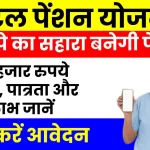$1,000 Monthly Payments: Imagine getting $1,000 every month with no strings attached. Sounds like a dream, right? This idea is becoming a reality for thousands of Americans thanks to new Universal Basic Income (UBI) and Guaranteed Income (GI) programs that are gaining momentum across the United States. In this in-depth guide, we’ll break down what these programs are, how they work, who qualifies, and what this could mean for your future — whether you’re looking to stabilize your finances or simply want to understand the evolving landscape of social support systems.

UBI isn’t just a futuristic buzzword or a policy reserved for academic debate anymore. In fact, it’s quickly becoming a central part of real-world experiments and discussions on economic justice. Whether you’re a single parent navigating daily expenses, an artist trying to make ends meet, or someone fascinated by innovative policy solutions, this comprehensive guide is designed to make UBI easy to understand and relevant to your life.
$1,000 Monthly Payments
| Feature | Details |
|---|---|
| Program Type | Universal Basic Income (UBI), Guaranteed Income (GI) |
| Monthly Amount | Up to $1,000 (varies by location and program) |
| Eligibility | Varies: income level, residency, occupation, demographics |
| Examples | Ohio Mothers Trust, UpTogether (MI & IL), Springboard for the Arts (MN), LA County GI |
| Funding Source | Local/state governments, private grants, nonprofit organizations, philanthropic funds |
| Purpose | Reduce poverty, support basic needs, stimulate local economies, promote equity |
| Official UBI Info | Stanford Basic Income Lab |
The idea of receiving $1,000 in monthly payments is no longer just an idealistic vision — it’s already improving lives across America. From increased financial security to better health outcomes and stronger communities, Universal Basic Income and Guaranteed Income initiatives are proving their worth in real-time.
If you’re facing economic challenges or just want to explore new possibilities, now is the time to investigate if you qualify for these programs. They offer more than money — they offer dignity, opportunity, and hope.
What Is Universal Basic Income (UBI)?
Universal Basic Income (UBI) is a type of economic policy where all citizens receive a consistent, guaranteed payment without conditions. This regular cash infusion is provided regardless of employment status, income level, or other qualifying factors. The core goal is to ensure every individual has access to a financial baseline to cover basic needs like housing, food, healthcare, and transportation.
The concept of UBI has roots stretching back centuries. Historical thinkers like Thomas Paine proposed basic income ideas in the 18th century, and civil rights leaders like Martin Luther King Jr. supported guaranteed income as a way to address systemic poverty. Today, the conversation is more relevant than ever as automation, inflation, and inequality reshape the American economy.
How Is UBI Different From Other Benefits?
Unlike traditional welfare, SNAP, or unemployment benefits, UBI doesn’t require you to jump through bureaucratic hoops. There’s no need to prove hardship, loss of income, or meet work requirements. Instead, UBI operates on the principle of universal support, meaning the funds are unconditional. This makes the system less stigmatizing, more accessible, and easier to manage both for recipients and administrators.
Why Now? The Rise of UBI and GI Programs in the U.S.
Over the past five years, particularly after the onset of the COVID-19 pandemic, interest in UBI and Guaranteed Income programs has skyrocketed. The crisis highlighted major cracks in the U.S. economic safety net. Sudden job losses, housing instability, and gaps in healthcare access revealed just how vulnerable many Americans are to financial shocks.
What Sparked the Surge in Interest?
Stimulus checks offered during the pandemic gave many a temporary taste of UBI. These payments helped people stay afloat, catch up on bills, and reduce anxiety. Seeing how effective a modest infusion of cash could be, researchers, local leaders, and nonprofits began launching pilot programs to explore long-term benefits. As economic pressures mount and technology displaces jobs, UBI is seen by many as a forward-thinking solution.
Examples of Active Programs:
- Ohio Mothers Trust: Offers $500/month to single mothers in Columbus to help cover childcare, rent, and education expenses.
- UpTogether in Michigan & Illinois: Provides $500/month to families earning below 80% of the area median income (AMI) through at least September 2025.
- Springboard for the Arts in Minnesota: A five-year initiative giving $500/month to 100 working artists, supporting creative freedom and financial resilience.
- Los Angeles County GI Program: One of the nation’s most ambitious GI trials, giving $1,000/month to 1,000 low-income residents over three years.
- Cambridge RISE (Massachusetts): Delivers $500/month to selected single caregivers, contributing to housing stability and family well-being.
These programs are often supported by private donors, philanthropic foundations, and partnerships with research institutions, allowing cities to collect valuable data on social and economic outcomes.
Who Qualifies for These Payments?
Eligibility depends on each program’s specific goals, but many share the following criteria:
- Income Level: Most programs target individuals or families earning under a certain percentage of the AMI.
- Residency Requirements: You must typically live in the city, county, or state administering the program.
- Demographics: Some initiatives focus on vulnerable populations, such as single mothers, formerly incarcerated individuals, or BIPOC communities.
- Age: Applicants are usually required to be 18 or older.
- Household Size: Certain programs prioritize families with children or caregivers.
If you’re unsure whether you qualify, check with the program’s official website. Organizations like UpTogether and Motherful Ohio regularly update eligibility requirements and deadlines.
How UBI Impacts Real People
The results from existing GI programs are overwhelmingly positive. According to a 2023 analysis by the Economic Security Project, households receiving GI support experienced:
- 66% reduction in food insecurity
- 40% increase in full-time employment
- Significant boosts in mental health, stability, and long-term planning
- Greater school attendance and academic success for children
- Reduction in payday loans and other forms of high-interest debt
One of the most talked-about pilots, the Stockton Economic Empowerment Demonstration (SEED), showed that UBI recipients found jobs faster than the control group and experienced less anxiety. Meanwhile, participants in Jackson, Mississippi’s Magnolia Mother’s Trust used funds to pursue higher education and maintain stable housing.
“I was finally able to breathe,” said one recipient. “The money gave me the peace of mind to plan ahead for the first time in years.”
Pros and Cons of UBI Programs
Pros
- Directly reduces poverty by offering consistent financial support
- Improves public health by decreasing stress-related illness and promoting stability
- Stimulates local economies through increased consumer spending
- Empowers recipients to pursue education, job training, or entrepreneurship
- Simplifies bureaucracy and saves administrative costs by reducing red tape
Cons
- High cost of implementation on a national scale could strain budgets
- Funding challenges make large-scale, long-term planning difficult
- Potential inflation risks, though not consistently supported by existing data
- Political opposition from groups skeptical of “free money” models
- Lack of standardization between programs complicates comparisons and scalability
How to Apply for UBI or GI Programs
Step 1: Research Local Opportunities
Start with a web search for UBI or GI programs in your city or state. Government websites, nonprofit newsletters, and media outlets often announce new pilot programs.
Step 2: Review Eligibility Requirements
Before applying, carefully read through criteria related to income, residency, and household demographics. Some programs also require participation in surveys or interviews to track progress.
Step 3: Gather Required Documentation
Be ready with:
- Income statements
- Proof of address
- Personal ID (e.g., driver’s license, state ID)
- Household composition details (number of dependents, marital status)
Step 4: Complete the Application
Applications are typically submitted online. Some programs use randomized lotteries to select recipients when applications exceed available spots.
Step 5: Prepare for Follow-Up
If selected, you may be asked to share feedback or participate in research studies. Most programs provide support channels in case you need help accessing or using your payments.
Step 6: Make a Financial Plan
Once enrolled, consider how to best use your funds. Many recipients use GI money to:
- Pay rent or utility bills
- Buy groceries and essentials
- Eliminate high-interest debt
- Save for emergencies
- Enroll in education or job-training programs
$2,400 Social Security Payments in April 2025 – Who’s Eligible to Get it? Check Payment Dates!
$4,018 Disability Payments Coming This April 2025; Are You on the List? Check Eligibility
FAQs About $1,000 Monthly Payments
Is UBI Available Nationwide?
Not yet. While UBI has strong support in some policy circles, there is no federal-level UBI program in the U.S. However, many states and cities continue to launch local pilots that could shape future legislation.
Will I Be Taxed on These Payments?
In most cases, GI payments are not taxable. However, tax rules can vary by state and funding source. Consult the IRS or a tax professional for guidance.
Can I Still Work While Receiving GI?
Yes! UBI and GI programs are designed to supplement your income, not replace it. Participants often use the extra support to pursue better jobs or launch side businesses.
Are These Programs Permanent?
Most are currently pilot programs, lasting 6 to 36 months. However, their success is influencing discussions on permanent adoption at broader scales.
How Are UBI Programs Funded?
Funding typically comes from a combination of city budgets, nonprofit grants, corporate sponsorships, and philanthropic donations.











